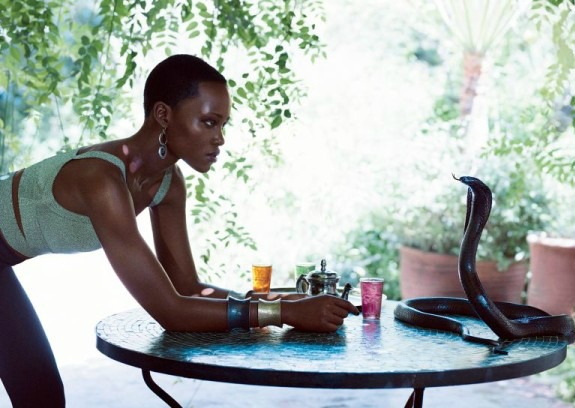Lupita Nyong’o’s recent Vogue cover shoot could have been so much more.
by Nicole Garner
It was the damn cobra that made it excruciatingly clear where this was going.
A sun-backed, slender, African woman leans over a tiled table, staring off into the distance. Next to her, a cobra flicks its tongue at her, body erect. The two look remarkably comfortable with one another.
But then again, why wouldn’t they? In the eyes of many Americans, Lupita Nyong’o, who was presented in that exact setting in Vogue‘s July issue, is as exotic and mystifying as the snake perched beside her.
Since her Oscar win for best supporting actress, Nyong’o has been deemed an ‘exotic beauty’ by digital and print media. While there’s been protest to steer clear of that frame, many publications keep running with the theme.
This month,Vogue did.
The rest of the July issue photoshoot, except for the cover, feels ripped from the reels of Indiana Jones and the Raiders of the Lost Ark, set to the backdrop of Marrakesh, a Moroccan city. Lupita poses in vivid markets, alongside backdrops of rich velvet on plush couches, and of course, with that damn cobra.
Vogue contributor Hamish Bowles dives deep into the attempt to whisk readers away to a far off, foreign place with beautiful, unknown and hued faces staring back at you.
“Lupita Nyong’o is cucumber-cool, as beautiful and hieratic as an ancient Egyptian statue of a cat goddess, dressed in Prada’s magenta Deco-print dress licked with silver that is dazzling against her luminous skin,” he writes about Nyogo’s first cover and the shoot.
But, that seems to be what Vogue wants. The magazine banks on Lupita’s ethnic identity, and the idea that presenting her as an African woman means calling up the conventional, stereotypical imagery Americans have learned to associate with that region and heritage — such as the vibrant prints, wild dancing and wild animals that can’t be tamed.
A video published with the package focuses on Nyong’o’s love for braiding hair — something that’s seemingly touted as being different or unique, yet a practice that many women of color have been familiar with since childhood.
While wearing braids isn’t exotic to many, I wonder if the presentation of the topic, paired with limited exposure of ethnic hair by many mainstream beauty magazines, pushes the video into the realm of mystique.
It begs the honest question, one that is obviously difficult to give a concrete answer to without intense content analysis, but should make you think: How many women in Vogue rock those bantu knots? Box braids? Cornrows? Twists and (after setting overnight or for a day – natural-haired gals, you know what I’m talking about) twist outs?
And to extend that further, what about Cosmo? Allure? Glamour? Elle? Marie Claire? Unless you’re picking up a copy of Sophisticate’s Black Hair, forget about seeing the beauty of ethnic hairstyles on a regular basis. The basis that makes them less mysterious, less obscure, less exotic.
While I’m happy to see the presentation of a realistic side of African and black culture, I wonder if an editorial board would have jumped at the concept had Nyong’o been a woman of a different ethnic background. Would the video have made its way past a storyboard if the cover girl was Gisele Bündchen, Angelina Jolie or Emma Stone? Further, would a photographer have placed those three in the same photoshoot setting?
Many comments on the video, both on Vogue’s website and throughout Facebook, praised the feature of black hair. But after watching, I couldn’t stop wondering how ethnicity works itself in the editorial process.
There’s no denying that the draw for the entire feature comes from Nyong’o’s Kenyan heritage. And there’s nothing wrong with pulling inspiration from her identity. But what is problematic is the framing magazines like Vogue use to depict women of African descent. Black women have two options in fashion magazines: the sleek diva (think Beyonce or Rihanna) or the avant-garde member of an urban, ethnic neighborhood or last unexplored jungle (like Solange Knowles or Lupita Nyong’o).
It seems an African woman, or woman of African heritage, can only be one, never in between – either exotic, or not. The July Vogue presentation reinforces that idea while perpetuating the notion that the value of a woman of color is based on her outward appearance and nationality.
What does it take to just be a successful woman of color — hell, even an unknown black model — without a throwback to Africa or the ‘hood?
I’m disappointed, to say the least. A prominent fashion magazine had the opportunity to think outside the frame and show Nyong’o in a way that expressed more than how westerners have thought about Africa and Africans for decades.
Maybe next time.
Nicole Garner is a reporter for the Nevada Daily Mail and a contributor for The Riveter. Follow her @nlgarner.
(Image credit: Mikael Jansson for Vogue)




